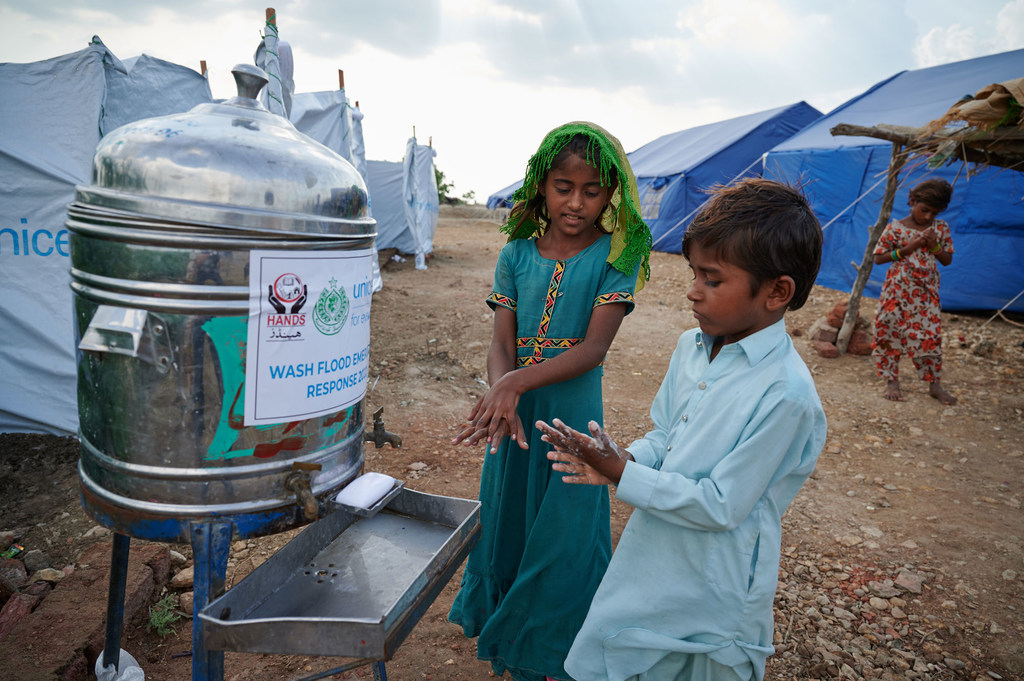[ad_1]
The examine, launched on Monday forward of the historic UN Water Conference, reviewed family entry to WASH providers, the burden of WASH-attributable deaths amongst youngsters below 5, and publicity to local weather and environmental hazards, revealing the place youngsters face the largest menace, and the place funding in options is desperately wanted to stop pointless deaths.
“Africa is going through a water disaster. Whereas local weather and water-related shocks are escalating globally, nowhere else on the planet do the dangers compound as severely for kids,” mentioned UNICEF Director of Programmes Sanjay Wijesekera.
“Devastating storms, floods, and historic droughts are already destroying amenities and houses, contaminating water sources, creating starvation crises, and spreading illness. However as difficult as the present circumstances are, with out pressing motion, the longer term could possibly be far more bleak.”

© UNICEF/Shehzad Noorani
Displaced youngsters wash their fingers exterior a public rest room at a camp in Sindh Province, Pakistan.
Crises compounded by armed battle
The triple menace was discovered to be most acute in Benin, Burkina Faso, Cameroon, Chad, Côte d’Ivoire, Guinea, Mali, Niger, Nigeria, and Somalia, making West and Central Africa one of many world’s most water-insecure and climate-impacted areas, in keeping with the evaluation. Lots of the worst-affected nations, notably within the Sahel, are additionally going through instability and armed battle, additional aggravating youngsters’s entry to wash water and sanitation.
Throughout the ten hotspots, almost one-third of youngsters don’t have entry to no less than fundamental water at residence, and two-thirds don’t have fundamental sanitation providers. 1 / 4 of youngsters haven’t any selection however to practise open defecation. Hand hygiene can also be restricted, with three-quarters of youngsters unable to clean their fingers due to lack of water and cleaning soap at residence.
Consequently, these nations additionally carry the heaviest burden of kid deaths from ailments attributable to insufficient WASH, equivalent to diarrhoeal ailments. For instance, six of the ten have confronted cholera outbreaks over the previous yr. Globally, greater than 1,000 youngsters below 5 die each day from WASH-related ailments, with round two out of 5 concentrated in these 10 nations alone.

© WHO/Rob Holden
Accelerated motion is required to make sure secure drinking-water, sanitation and hygiene for all.
Weak to local weather threats
These hotspots additionally rank throughout the prime 25 per cent of 163 nations globally with the best threat of publicity to local weather and environmental threats. Greater temperatures – which speed up pathogen replication – are rising 1.5 occasions sooner than the worldwide common in elements of West and Central Africa. Groundwater ranges are additionally dropping, requiring some communities to dig wells twice as deep as only a decade in the past. On the similar time, rainfall has develop into extra erratic and intense, resulting in floods that contaminate scarce water provides.
All 10 nations are additionally categorised by the Organisation for Financial Cooperation and Growth (OECD) as fragile or extraordinarily fragile, with the stresses of armed battle in some nations threatening to reverse progress towards secure water and sanitation.
For instance, Burkina Faso has seen a ramping up of assaults on water amenities as a tactic to displace communities. Fifty-eight water factors have been attacked in 2022, and greater than 830,000 folks – over half of whom are youngsters – misplaced entry to secure consuming water within the final yr.
[ad_2]

